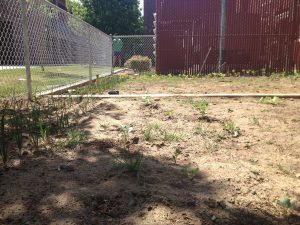
If you’ve walked behind the B building recently, you’ve probably noticed a small patch of soil enclosed by a fence. It is a modest size, measuring 30 by 24 feet. This is the new MVHS garden known as the Matador Meadow. Completely student run, the garden is a wonderful idea that has been successful in other schools nationwide, and will be the same for MVHS as well. It promotes healthy eating, scientific exploration and ingenuity to students while giving them the opportunity to form a bond with nature.
The garden was formally unveiled to the public with a ribbon cutting ceremony on March 21, and students have already taken great interest in it. With the garden’s opening, students immediately approached science teacher Andrew Goldenkranz and asked to start a club to organize regular work days — especially during vacation time — when students will partake in basic maintenance.
Goldenkranz imagines it as an edible garden.
“[We are still working out] whether we are going to be able to use some of it to supply to the cafeteria, and whether some of it goes to a soup kitchen or a food bank,” Goldenkranz said.
So far, five trees have been planted, but he envisions growing some annuals and perennials as well. Students in his science classes and members of the club will be able to work on the garden.
Knowing that their labor has resulted in the food they consume, students will be encouraged to eat food with ingredients from the garden. Even if students did not personally participate in growing the crops, they will still wish to eat them because of the local source: the ingredients will have been grown on campus by friends and classmates.
A student-run garden will provide an opportunity for more depth in science education. Instead of just learning about concepts in class, students will be able to apply their knowledge in a practical sense and see it in action. Future AP Environmental Science students will have the chance to conduct soil testing, while biology students can use the garden as a tool to learn about evolution and genetics. The addition of a garden allows for possibilities that were not previously available. After students learn about a particular topic through lecture or reading, it is useful to see it represented in a more concrete way, where they can experience it firsthand. In addition, it would be more enjoyable for students to actively learn rather than passively absorb information.
Along with the implications for health and education, Matador Meadows brings back the fundamental connection a person has with nature. In fast-paced and highly industrialized Silicon Valley, people value their commodities more than the beauty of the natural world. The garden will give students those undiluted feelings that accompany being in nature, which have been lacking in many of our lives. Goldenkranz has noticed that just spending time in the soil, despite getting dirty, makes students happier.
“I listen to students, and they’re like, ‘Oh, I have to go visit my plants,’ because they know they planted them the other day,” Goldenkranz said. “And so they take a real ownership of that, they [are] appreciating that it’s a living thing.”
Matador Meadow may also be able to inspire creativity. For example, a shoe stuffer in the garden is filled with herbs rather than shoes in order to save space and maximize the amount of land by growing the herbs vertically. It is a reflection of the innovation to come; Goldenkranz uses the term “high tech, high touch” to describe his vision of complex technology that produces something simple and utilitarian.
Developing and implementing various devices is a great way for students to collaborate with each other and invest their time in future projects.
Matador Meadow is a positive installment to the MVHS campus that has an impact on students both directly and indirectly. It is something that students will learn to appreciate and enjoy in years to come.
“That’s the thing about a garden, it takes care and love.” Goldenkranz said. “You can’t just leave it alone.”
Nationwide, student gardens have been popping up. They are a positive attribute to the students in but not limited to health, creativity, and education.







